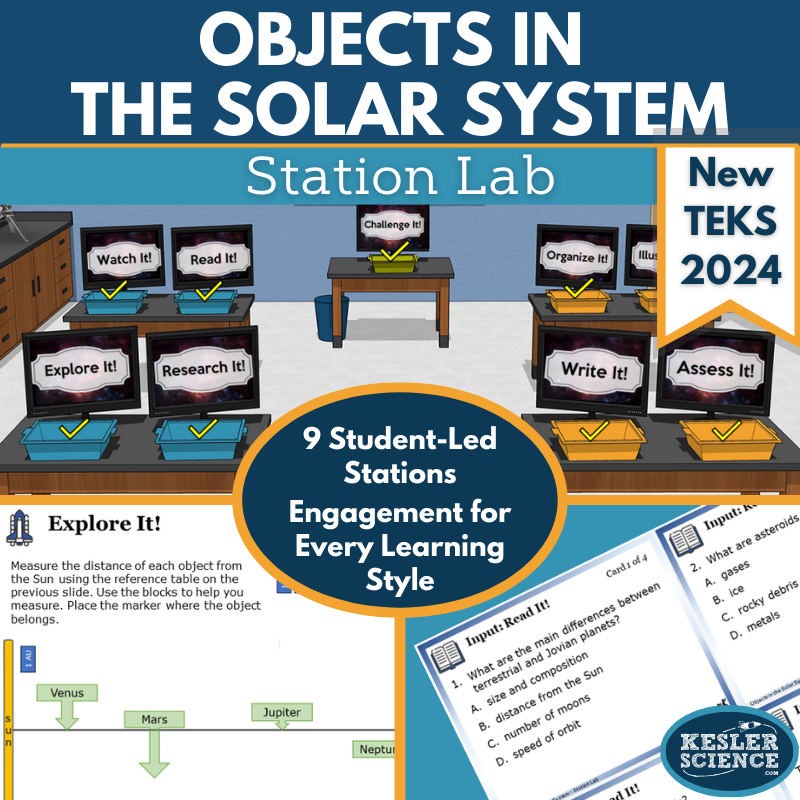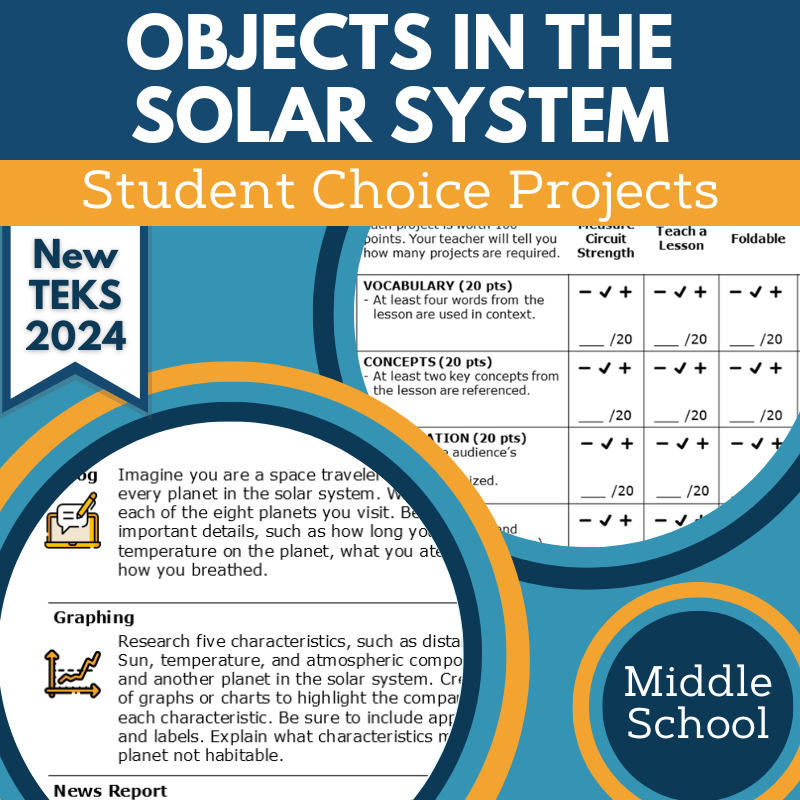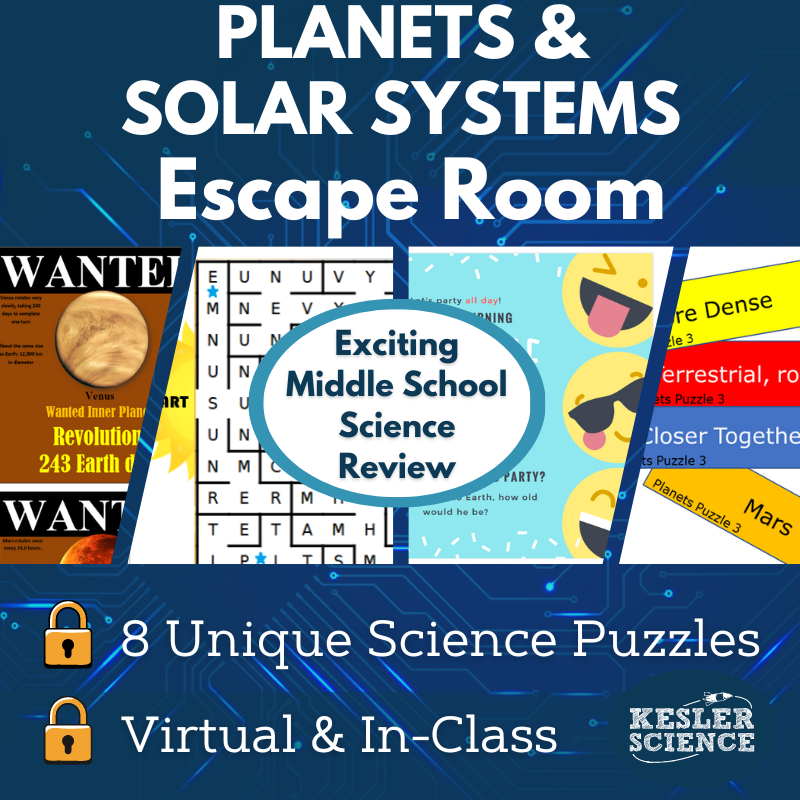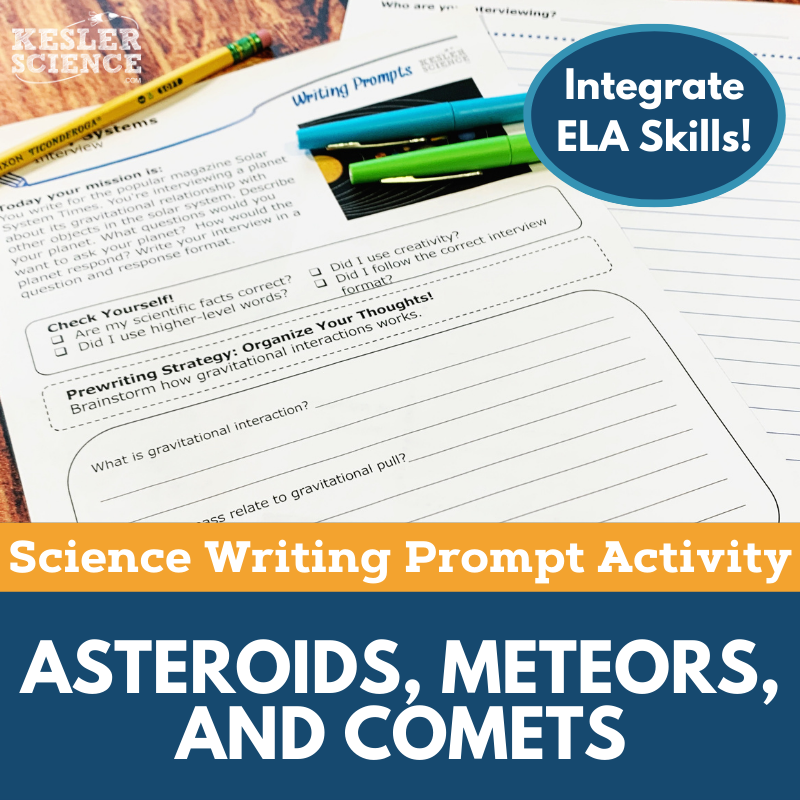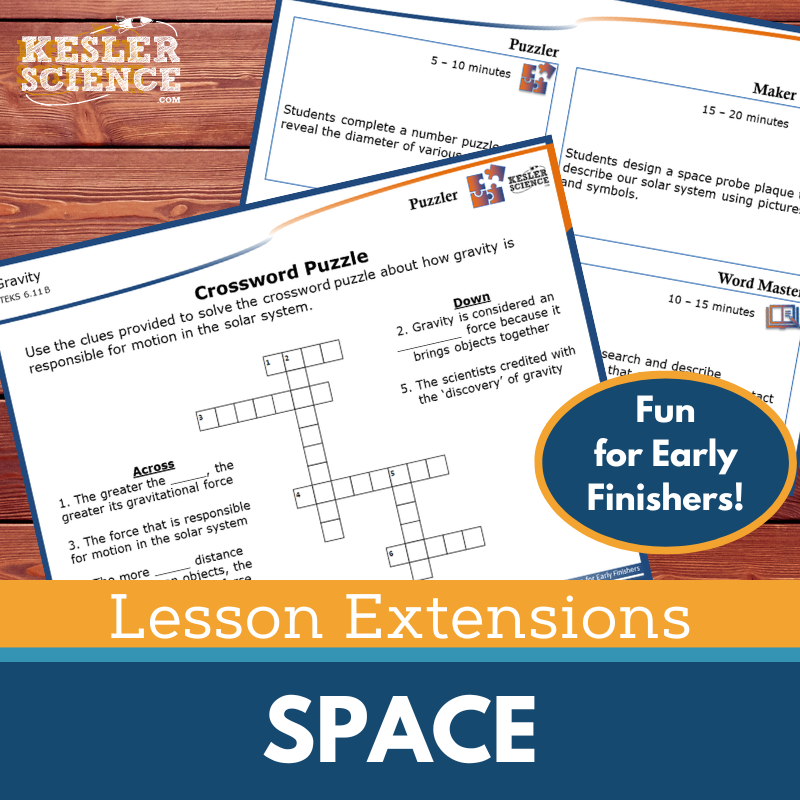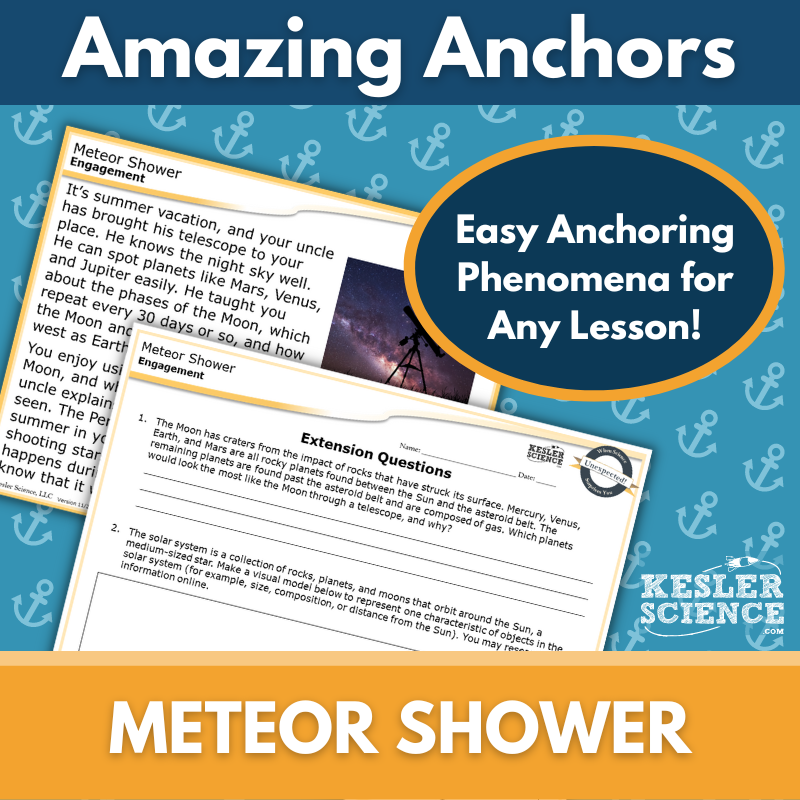Objects in the Solar System Activities for Middle School Science
Explore the physical properties, locations, and movements of objects in the solar system with this engaging TEKS-aligned lesson. The resources below will give students a comprehensive understanding of objects in the solar system. All of the following materials are also included in the Kesler Science Membership.
The Kesler Science Objects in the Solar System 5E Lesson is a comprehensive, student-led unit covering the physical properties, locations, and movements of objects in the solar system, including the Sun, planets, moons, meteors, asteroids, comets, the Kuiper belt, and the Oort cloud. This fully editable, low-prep lesson includes presentations, worksheets, choice projects, and assessments, ensuring differentiated, multimodal learning aligned with TEKS 7.9A.
Following the 5E Model, the lesson begins with engaging class discussions and vocabulary support in English and Spanish. The hands-on Exploration phase features a nine-station student-led lab with activities such as experiments, reading passages, videos, research tasks, card sorts, writing prompts, and illustration exercises. Editable PowerPoints and interactive notebook templates in English and Spanish support Explanation. Students extend learning through choice projects, while Evaluation includes STAAR 2.0-aligned assessments, review questions, and worksheets.
Designed for flexibility, this lesson is available in digital and printable formats, making it ideal for both in-person and virtual learning.
The Kesler Science Objects in the Solar System 5E Lesson is a comprehensive, student-led unit covering the physical properties, locations, and movements of objects in the solar system, including the Sun, planets, moons, meteors, asteroids, comets, the Kuiper belt, and the Oort cloud. This fully editable, low-prep lesson includes presentations, worksheets, choice projects, and assessments, ensuring differentiated, multimodal learning aligned with TEKS 7.9A.
Following the 5E Model, the lesson begins with engaging class discussions and vocabulary support in English and Spanish. The hands-on Exploration phase features a nine-station student-led lab with activities such as experiments, reading passages, videos, research tasks, card sorts, writing prompts, and illustration exercises. Editable PowerPoints and interactive notebook templates in English and Spanish support Explanation. Students extend learning through choice projects, while Evaluation includes STAAR 2.0-aligned assessments, review questions, and worksheets.
Designed for flexibility, this lesson is available in digital and printable formats, making it ideal for both in-person and virtual learning.
Engage your students with this student-led station lab aligned with the 2021 TEKS 7.9A standard. This interactive Earth science lesson allows students to explore the physical properties, locations, and movements of the Sun, planets, moons, meteors, asteroids, comets, Kuiper belt, and Oort cloud through nine differentiated stations.
Students learn through multimodal input stations, including hands-on experiments, video analysis, reading passages in English and Spanish, and research-based activities. Output stations encourage students to demonstrate their understanding by organizing information, illustrating models, writing responses, and completing assessments. A bonus challenge station provides extension activities for advanced learners.
Designed for in-class or virtual learning, this low-prep resource fosters engagement, critical thinking, and personalized learning.
Engage your students with this student-led station lab aligned with the 2021 TEKS 7.9A standard. This interactive Earth science lesson allows students to explore the physical properties, locations, and movements of the Sun, planets, moons, meteors, asteroids, comets, Kuiper belt, and Oort cloud through nine differentiated stations.
Students learn through multimodal input stations, including hands-on experiments, video analysis, reading passages in English and Spanish, and research-based activities. Output stations encourage students to demonstrate their understanding by organizing information, illustrating models, writing responses, and completing assessments. A bonus challenge station provides extension activities for advanced learners.
Designed for in-class or virtual learning, this low-prep resource fosters engagement, critical thinking, and personalized learning.
The Objects in the Solar System Student Choice Projects align with the 2021 TEKS standard 7.9A, allowing middle school students to choose a project that fits their preferred output style. A project page outlines six student-led options plus a “design your own” project, all with an editable rubric for teacher, peer, or self-assessment. This resource is also included in the Objects in the Solar System Complete Lesson for TEKS 7.9A.
These flexible, multimodal projects provide creative ways for students to demonstrate their understanding. Two versions of the project page support differentiation, with modified options for students needing remediation and challenge options for advanced learners. Teachers can adjust the rubric to fit grading needs.
The projects use standard classroom supplies like paper, markers, and scissors, and many options are available for digital completion.
The Objects in the Solar System Student Choice Projects align with the 2021 TEKS standard 7.9A, allowing middle school students to choose a project that fits their preferred output style. A project page outlines six student-led options plus a “design your own” project, all with an editable rubric for teacher, peer, or self-assessment. This resource is also included in the Objects in the Solar System Complete Lesson for TEKS 7.9A.
These flexible, multimodal projects provide creative ways for students to demonstrate their understanding. Two versions of the project page support differentiation, with modified options for students needing remediation and challenge options for advanced learners. Teachers can adjust the rubric to fit grading needs.
The projects use standard classroom supplies like paper, markers, and scissors, and many options are available for digital completion.
The Objects in Space Inquiry Lab aligned with TEKS guides students in analyzing the orbital distances and revolutionary periods of planets in our solar system. This resource includes four labs, one of which involves outdoor measurements, while the others provide data for analysis, allowing flexibility in lesson planning. Students will use this information to make predictions about other planets.
The lab set includes three differentiated versions to support diverse learning needs. The Dependent Student Lab offers a blend of procedural instructions and guided inquiry, making it suitable for on-level learners. The Modified Student Lab provides the most structured experience, incorporating sentence stems and multiple-choice questions for students requiring modifications. The Independent Student Lab is highly student-centered, allowing advanced learners to make their own decisions throughout the process.
Teacher resource pages include prep time guidance, standards, objectives, directions, materials lists, and additional resources. Answer keys, CER conclusion prompts, and reflection questions help facilitate student learning. All pages are editable.
Materials needed per group include various lengths of yarn (1 m, 1.5 m, 5 m, 10 m) and access to a large outdoor space or gym. This hands-on experience provides an engaging way for students to explore planetary motion.
The Objects in Space Inquiry Lab aligned with TEKS guides students in analyzing the orbital distances and revolutionary periods of planets in our solar system. This resource includes four labs, one of which involves outdoor measurements, while the others provide data for analysis, allowing flexibility in lesson planning. Students will use this information to make predictions about other planets.
The lab set includes three differentiated versions to support diverse learning needs. The Dependent Student Lab offers a blend of procedural instructions and guided inquiry, making it suitable for on-level learners. The Modified Student Lab provides the most structured experience, incorporating sentence stems and multiple-choice questions for students requiring modifications. The Independent Student Lab is highly student-centered, allowing advanced learners to make their own decisions throughout the process.
Teacher resource pages include prep time guidance, standards, objectives, directions, materials lists, and additional resources. Answer keys, CER conclusion prompts, and reflection questions help facilitate student learning. All pages are editable.
Materials needed per group include various lengths of yarn (1 m, 1.5 m, 5 m, 10 m) and access to a large outdoor space or gym. This hands-on experience provides an engaging way for students to explore planetary motion.
The Planets Escape Room is an engaging, interactive activity that allows students to demonstrate their understanding of the characteristics of inner and outer planets in a fun and immersive way. Aligned with TEKS and NGSS, this escape room reinforces concepts related to the physical properties, locations, and movements of celestial bodies within the solar system.
Teachers have full control over the eight independent puzzles, choosing which to use and in what order, making it adaptable for different class lengths. The escape room can be conducted using manila envelopes and included printed materials or with a more authentic setup involving locks and a lockbox. A digital version is available for individual student use via PowerPoint or Google Slides, with printable options for home use.
This resource includes teacher directions, detailed answer keys, a digital answer sheet (Google Form), a video challenge, editable templates, and printable props. Also included are reward templates, a list of over 50 prize ideas, and 30 unique signs for students to hold in their final photos. This exciting escape room will keep students engaged and talking about their learning experience for weeks!
The Planets Escape Room is an engaging, interactive activity that allows students to demonstrate their understanding of the characteristics of inner and outer planets in a fun and immersive way. Aligned with TEKS and NGSS, this escape room reinforces concepts related to the physical properties, locations, and movements of celestial bodies within the solar system.
Teachers have full control over the eight independent puzzles, choosing which to use and in what order, making it adaptable for different class lengths. The escape room can be conducted using manila envelopes and included printed materials or with a more authentic setup involving locks and a lockbox. A digital version is available for individual student use via PowerPoint or Google Slides, with printable options for home use.
This resource includes teacher directions, detailed answer keys, a digital answer sheet (Google Form), a video challenge, editable templates, and printable props. Also included are reward templates, a list of over 50 prize ideas, and 30 unique signs for students to hold in their final photos. This exciting escape room will keep students engaged and talking about their learning experience for weeks!
This Science Reading Comprehension Lesson helps students explore objects in space by reading a nonfiction article about the physical properties, locations, and movements of astronomical bodies. Students answer comprehension questions, research the Hubble Telescope, and create an infographic to deepen their understanding.
Designed for grades 6-8, with higher-level 5th graders in mind, the passage supports science literacy and reading comprehension. The resource includes two leveled articles (Lexile 1100-1300), five to seven comprehension questions, and a hands-on mini-project. A Cornell notes template is provided for additional support.
Perfect for sub plans, extra credit, ISS, or whole-class instruction, this resource fosters critical thinking and classroom discussions. It is compatible with virtual learning platforms like Google Classroom, MS Teams, Schoology, and Canvas, allowing students to complete assignments digitally.
This Science Reading Comprehension Lesson helps students explore objects in space by reading a nonfiction article about the physical properties, locations, and movements of astronomical bodies. Students answer comprehension questions, research the Hubble Telescope, and create an infographic to deepen their understanding.
Designed for grades 6-8, with higher-level 5th graders in mind, the passage supports science literacy and reading comprehension. The resource includes two leveled articles (Lexile 1100-1300), five to seven comprehension questions, and a hands-on mini-project. A Cornell notes template is provided for additional support.
Perfect for sub plans, extra credit, ISS, or whole-class instruction, this resource fosters critical thinking and classroom discussions. It is compatible with virtual learning platforms like Google Classroom, MS Teams, Schoology, and Canvas, allowing students to complete assignments digitally.
The Asteroids, Meteors, and Comets Science Writing Prompt Activity engages middle school students in an interactive letter-writing exercise to test their understanding of Earth science. Aligned with TEKS, this activity reinforces concepts related to the physical properties, locations, and movements of the Sun, planets, moons, meteors, asteroids, and comets. Designed for both in-person and virtual learning, it encourages science reasoning, creativity, and writing skills.
This resource includes teacher directions with answer guides and rubrics, projection and print handouts in full and half-sheet formats, and a digital PowerPoint version compatible with Google Slides. It serves as a versatile tool for cross-curricular activities, pre-test assessments, student choice projects, early finisher tasks, extra credit, make-up work, TELPAS samples, and differentiation exercises. Students’ responses can be displayed on a bulletin board or compiled into an anthology, making this a valuable addition to any science classroom.
The Asteroids, Meteors, and Comets Science Writing Prompt Activity engages middle school students in an interactive letter-writing exercise to test their understanding of Earth science. Aligned with TEKS, this activity reinforces concepts related to the physical properties, locations, and movements of the Sun, planets, moons, meteors, asteroids, and comets. Designed for both in-person and virtual learning, it encourages science reasoning, creativity, and writing skills.
This resource includes teacher directions with answer guides and rubrics, projection and print handouts in full and half-sheet formats, and a digital PowerPoint version compatible with Google Slides. It serves as a versatile tool for cross-curricular activities, pre-test assessments, student choice projects, early finisher tasks, extra credit, make-up work, TELPAS samples, and differentiation exercises. Students’ responses can be displayed on a bulletin board or compiled into an anthology, making this a valuable addition to any science classroom.
The WIKI Tickets© Space Set provides engaging, flexible formative assessments for 6th-8th grade science. This set includes 14 topics, each available in five formats: a full-screen display for projection, three printable handouts (full, split, and quarter-page), and an interactive digital version compatible with PowerPoint and Google Slides.
Aligned with NGSS and TEKS standards, these assessments cover key space science concepts, including the lunar cycle, H-R diagram, solar system gravity, space exploration, and the electromagnetic spectrum. A bonus table of contents file outlines standard alignment.
Designed for both in-person and virtual learning, WIKI Tickets© can be used as exit tickets, bellringers, or quick checks. Students can respond on their own paper, printed handouts, or digitally in a 1:1 or remote setting. These colorful, engaging assessments help you quickly gauge student understanding in any learning environment.
The WIKI Tickets© Space Set provides engaging, flexible formative assessments for 6th-8th grade science. This set includes 14 topics, each available in five formats: a full-screen display for projection, three printable handouts (full, split, and quarter-page), and an interactive digital version compatible with PowerPoint and Google Slides.
Aligned with NGSS and TEKS standards, these assessments cover key space science concepts, including the lunar cycle, H-R diagram, solar system gravity, space exploration, and the electromagnetic spectrum. A bonus table of contents file outlines standard alignment.
Designed for both in-person and virtual learning, WIKI Tickets© can be used as exit tickets, bellringers, or quick checks. Students can respond on their own paper, printed handouts, or digitally in a 1:1 or remote setting. These colorful, engaging assessments help you quickly gauge student understanding in any learning environment.
Lesson Extensions provide student-choice activities that engage early finishers with critical thinking and creativity while reinforcing space science concepts. These activities help scaffold learning, prevent distractions, and serve as meaningful lesson wrap-ups.
Each extension includes four interactive components: Puzzler for problem-solving, Maker Space for hands-on STEAM activities, Tech Connection for digital demonstrations, and Word Master for creative writing. With teacher directions, answer keys, and both print and projection versions, these extensions provide rigorous yet enjoyable learning opportunities.
Covering topics such as the components of the universe, gravity, the lunar cycle, space travel, and the Sun, moon, and tides, these extensions align with NGSS and TEKS science standards, ensuring students can explore space science in depth.
Lesson Extensions provide student-choice activities that engage early finishers with critical thinking and creativity while reinforcing space science concepts. These activities help scaffold learning, prevent distractions, and serve as meaningful lesson wrap-ups.
Each extension includes four interactive components: Puzzler for problem-solving, Maker Space for hands-on STEAM activities, Tech Connection for digital demonstrations, and Word Master for creative writing. With teacher directions, answer keys, and both print and projection versions, these extensions provide rigorous yet enjoyable learning opportunities.
Covering topics such as the components of the universe, gravity, the lunar cycle, space travel, and the Sun, moon, and tides, these extensions align with NGSS and TEKS science standards, ensuring students can explore space science in depth.
This Amazing Anchors Phenomenon Lesson engages students in learning about the movement and position of objects in space through the real-world example of meteor showers. It includes an introductory reading with comprehension and extension questions to prepare students for further learning, followed by an explanatory reading that simplifies the science behind meteor showers and object movement in space, reinforcing understanding with additional questions.
Aligned with TEKS, this no-prep resource includes teacher directions, answer keys, projection slides, and both print and digital formats for Google Classroom and other LMS platforms. A modified version provides sentence starters for student support. Designed to bookend a lesson, these engaging readings serve as valuable supplements in any in-person or virtual classroom.
This Amazing Anchors Phenomenon Lesson engages students in learning about the movement and position of objects in space through the real-world example of meteor showers. It includes an introductory reading with comprehension and extension questions to prepare students for further learning, followed by an explanatory reading that simplifies the science behind meteor showers and object movement in space, reinforcing understanding with additional questions.
Aligned with TEKS, this no-prep resource includes teacher directions, answer keys, projection slides, and both print and digital formats for Google Classroom and other LMS platforms. A modified version provides sentence starters for student support. Designed to bookend a lesson, these engaging readings serve as valuable supplements in any in-person or virtual classroom.
Year-Round Resources
These year-round activities will increase your students' understanding of many middle school science topics. All of these activities are also included in the Kesler Science Membership.
Visual Data & Graphing
You're not alone if your students struggle with understanding graphs, charts, and tables. It's a skill that takes an enormous amount of practice. This resource will help students build a strong foundation in analyzing data and creating their own data visualizations.
Bell Ringers and Warm-Ups
These middle school science bell ringers are an excellent way to engage your students as soon as they walk into your classroom. This comprehensive FULL YEAR resource includes everything you need to start off each science class with an interesting warm-up activity.
Review Board Games
Each game board has been carefully designed to keep students engaged. There are 10 different action spaces on each board and dozens of question cards. All of the actions are related to science concepts and keep the students motivated throughout the game.
Each game is ready to play. Simply print out the board and the cards and let the students enjoy reviewing nine different units.
Essential Questions and Standards
Below are the essential questions and standards associated with the lessons and activities included in the atoms unit. This topic is only one of more than 100 middle school science topics included in the Kesler Science Membership.
-
What are the physical properties of objects in our solar system?
-
Where can objects in our solar system be found, and how do they move?
-
TEKS Science - 7.9A Objects in the Solar System
Kesler Science Membership
Imagine never having to search for another middle school science lesson again. The membership gives you access to ALL of the Kesler Science products in one place (Yes, including everything above).
Say goodbye to long hours of lesson prep.



